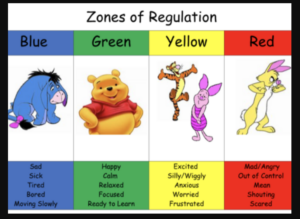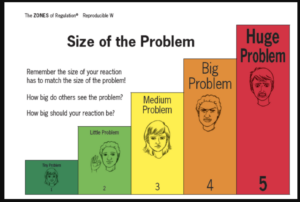Zones Of Regulation
In school your children are learning to self regulate using ‘The Zones of Regulation.’ This may be useful to use as a strategy to support your children at home.
“Life is 10% what happens to us and 90% how we react to it.” Charles Swindoll

Why use the zones of regulation at home?
- It supports the use of a consistent shared language to discuss emotions together.
- They are simple for children to understand.
- It supports children to label emotions and identify how they are feeling.
- It helps children to understand that there are no bad emotions.
- Children learn healthy coping and regulation strategies which allow them to, eventually help themselves when they lose control of their emotions, become stressed, anxious or sad.
- Typically, children who can self-regulate will turn into teens and young adults who can self-regulate.
- Understanding the emotions of others helps with empathy and friendship skills.
-
What Can I do as a Parent?
Talk to your child about:
- How they are feeling, help them to label and name their emotion. Identify your own feelings using Zones language in front of your child (e.g. “I’m frustrated, I am in the yellow zone”)
- Talk about their body cues when they feel that emotion. What are the physical feelings behind the emotion (e.g feeling butterflies in our tummy when we feel nervous or worried.) Recognising emotions is the first step to regulating them.
Here are some examples from the four zones:
Blue- I can see and hear that you are crying, your mouth is turned down, are you feeling sad?
Green- I can see your big smile and hear your laughter, are you feeling happy?
Yellow- You have become very quiet and I can see that you are reluctant to speak, are you feeling worried?
Red- I can hear that you are breathing heavily and I can see that your eyebrows have bunched together, are you feeling angry?- Discuss why they are feeling a certain way, has anything happened?
- Talk about times when you, a family member or a character from a film or book felt that way.
When children are stuck…
We encourage children to think of the strategies that they use to support them when they are in a zone as their ‘tools.’
Deep breathing is one of the many beneficial strategies to teach your child-
Your child can learn to change short, shallow breaths that can cause hyperventilation to deep, long breaths that help create a feeling of internal calmness. Short, shallow breaths tend to make feelings of anxiety and anger worse, hence calm breathing can give your child a sense of control and relief. Yoremikids has some great breathing techniques, click on the link to give them a try.
https://www.yoremikids.com/news/best-breathing-exercises-for-kidsHere are some more strategies you might like to try:
1 Think of something that makes you laugh
2 Squeeze a stress ball or pillow as hard as you can
3 Go for a walk
4 Slowly count backward from 10
5 Swing on a swing
6 Draw a picture of something that makes you happy
7 Do a doodle.
8 Write a letter or send an email
9 Listen to music
10 Play with play-doh
11 Talk to a grown-up
12 Talk to a friend
13 Use positive affirmations
14 Make a list of things that you love
15 Close your eyes and think about your favourite place
16 Read a book17 Rip up paper
18 Dance
19 Do some yoga
20 Ask for a hug
21 Hug your favourite stuffed animal
22 Watch funny videos
23 Build with Lego
24 Do 10 jumping jacks
25 Spend time with a pet
26 Look through a photo album
27 Use a fidget toy
28 Go outside
29 Get some sleep
30 Have a healthy snackA story we have used in school to support children to understand is ‘The Colour Monster’The Colour Monster

The zones of regulation ‘size of the problem’ teaches children to consider the size of their problem in contrast to the size of their reaction. It is an emotional regulation tool that can guide children to self regulate their emotions, in order to respond appropriately.
It helps children to know and understand the following:- Problems come in different sizes
- Emotions and reactions come in different sizes
- Reactions come from emotions
- It’s expected that the size of the emotion and related reaction matches the size of the problem
By teaching children this, we help establish norms around defining and emotionally responding to a problem.
Problems
Often a problem that is encountered by a child is something that happens that was not part of the plan and negatively influences it. Problems can make children feel uncomfortable and come in different sizes.
Reactions
Reactions to problems come from our feelings. A reaction is what we show on the outside by what we say and do. Just as problems and feelings come in different sizes, so do our reactions. It’s expected that the size of the reaction on the outside should match the size of the problem.What can I do as a Parent?
Highlight naturally occurring times when you (as the caregiver) encounter a problem. It’s important for your child to understand that you are constantly being challenged by problems of all sizes.
Thinking out loud about problems and their solutions models the language of problem solving for your child.
In using the language of problem solving, it may be helpful to follow a formula of sorts in breaking down a problem or situation.
⦁ What happened
⦁ The size of the problem
⦁ How you felt about it
⦁ Ideas for solving the problem or making it smaller
⦁ What you did
⦁ How you felt about it afterwards
Here are a few examples:
“This morning I spilled my coffee on the table when I was reaching for some fruit. I felt really frustrated and cross because I wanted to drink it and I had made a mess. Then I thought about how it was just a small problem. I stayed caIm, wiped up the spill and poured myself another cup. It was quick and easy to fix that problem. I felt proud of myself for staying calm.”
“I really wanted to wear my green shirt today, but I spilled yogurt on it. I was disappointed. I thought about how I could wash it and wear it another day. I stayed calm and changed into another shirt. It was just a small problem, no big deal.”
Reinforce times when you observe your child engaged in problem solving and demonstrating small reactions to small problems e.g “Wow, when your crayon broke you stayed calm, and chose a different colour to finish your picture. It didn’t take very long to get another crayon and you made the problem smaller all by yourself!”
Together, explore some of the stories below in which the characters experience problems and work hard to solve them. Discuss the characters reactions. Do their reactions match the size of the problem?
